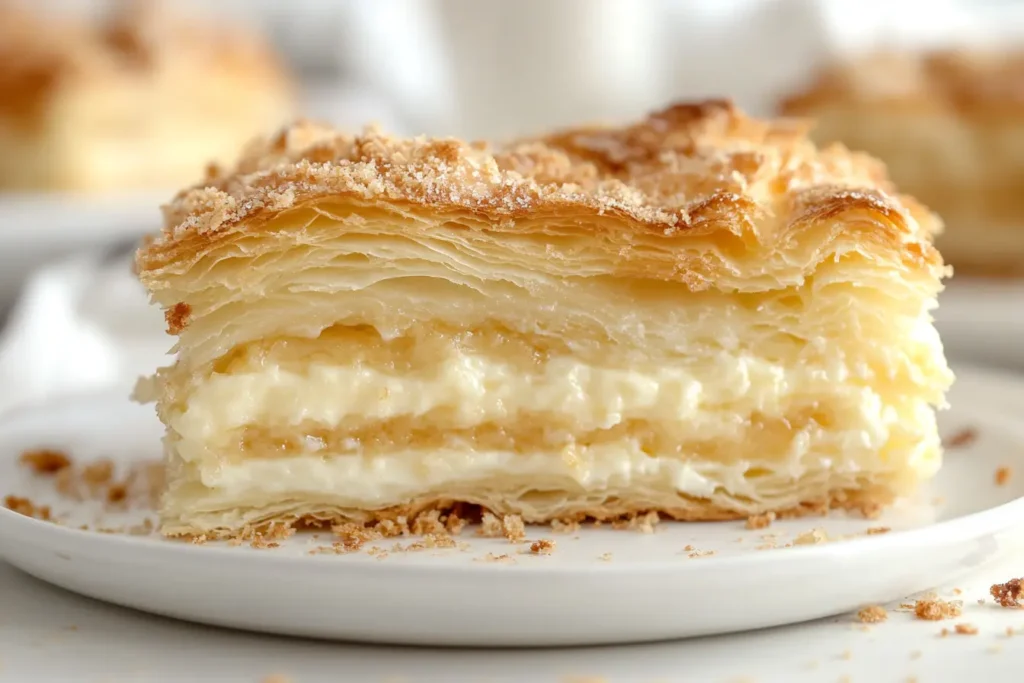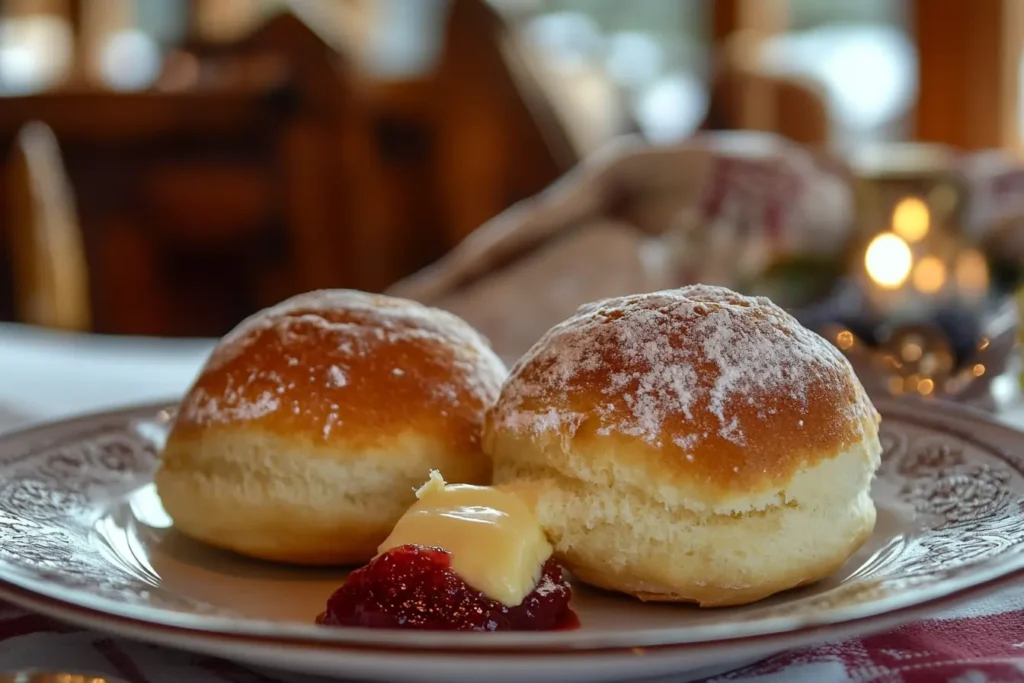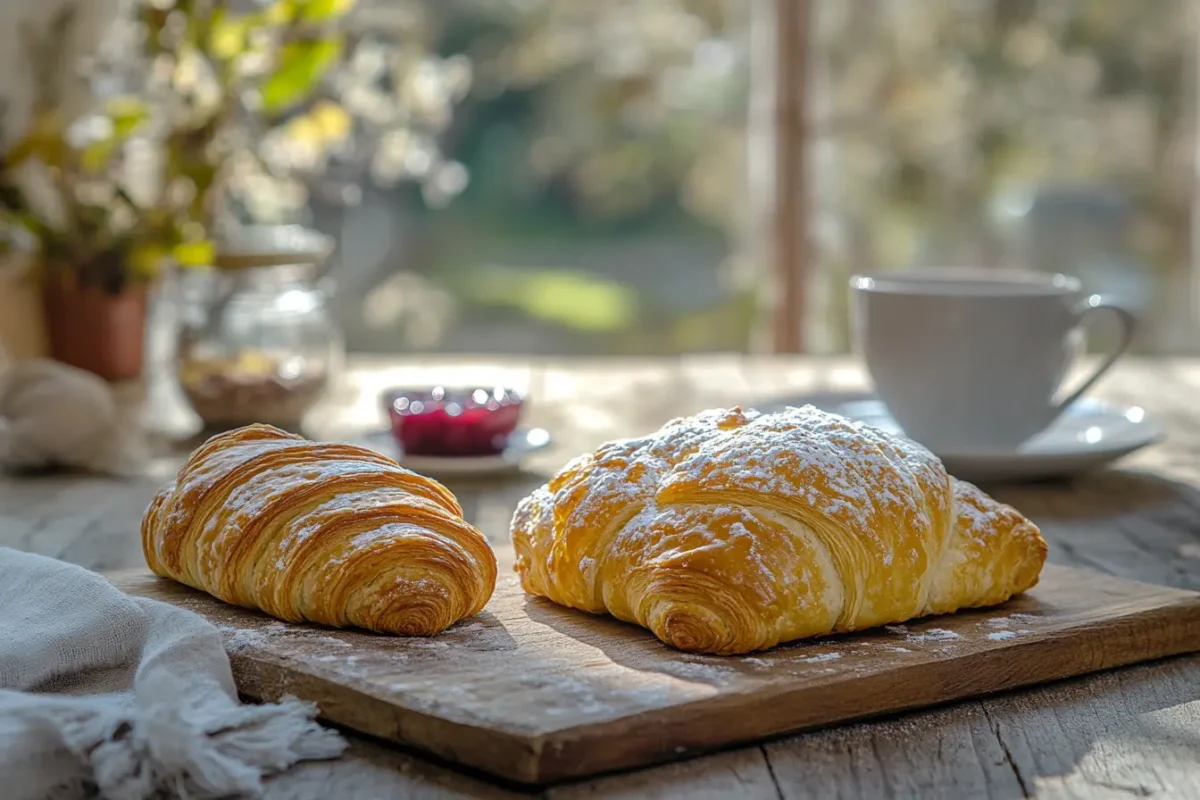Delve into the world of pastries to uncover the subtle yet fascinating differences between the iconic French croissant and Switzerland’s beloved gipfeli. While these crescent-shaped treats may look similar at a glance, their textures, flavors, and cultural significance tell two very distinct stories. This article explores their origins, unique characteristics, and shared heritage, ensuring you’ll never confuse these delightful baked goods again.
What is the Difference Between a Croissant and a Gipfeli? Introduction to These Pastries
Overview: What is the Difference Between a Croissant and a Gipfeli?
Pastries have long been a staple of breakfasts and snacks across the world, but few are as iconic as the croissant and the gipfeli. While the croissant has earned its place as a French cultural symbol, the gipfeli, a Swiss favorite, carries a more understated charm. Both pastries share a crescent shape but vary in texture, taste, and ingredients.
The croissant, known for its buttery, flaky layers, has origins steeped in Viennese and French baking traditions. On the other hand, the gipfeli is a denser, subtly flavored treat that reflects the simplicity of Swiss baking culture. Both pastries have evolved to fit local preferences, adding to their unique allure.
Why Compare Croissants and Gipfeli?
You might wonder, what is the difference between a croissant and a gipfeli, and why does it matter? Well, these pastries represent more than just food; they embody centuries of culinary history and cultural identity. Understanding their distinctions helps us appreciate the artistry that goes into making each one.
By exploring the differences in ingredients, texture, shape, and cultural significance, this article will illuminate how these pastries have carved their unique niches in global cuisine. Whether you’re a casual foodie or an avid baker, there’s something to learn (and love) about these crescent-shaped delights.
Defining Croissants: What Sets Them Apart from Gipfeli?
Ingredients in Croissants: Key to Their Flaky Texture
Croissants are beloved for their buttery, flaky texture, and the magic starts with the ingredients. Traditional croissants are made with high-fat European butter, strong flour, milk, sugar, yeast, and a pinch of salt. The butter is carefully laminated into the dough, creating the signature layers that separate croissants from other pastries. Unlike gipfeli, croissants rely heavily on butter, making them richer and more indulgent.
The choice of ingredients, especially the butter, defines the croissant’s flavor and texture. French bakers often emphasize using premium butter with high moisture content, which not only enhances flavor but also contributes to the pastry’s delicate structure.
What Makes Croissants Unique? Texture and Flavor

Croissants are celebrated for their golden, flaky crust and tender, airy interior. Each bite offers a satisfying crunch followed by a soft, melt-in-your-mouth sensation. The buttery richness and subtle sweetness make them perfect for both savory and sweet pairings. Common fillings include chocolate, almond paste, and ham and cheese, elevating the pastry into a versatile treat.
What sets croissants apart is their intricate layering, achieved through a meticulous folding and rolling process. These layers trap steam during baking, creating the distinct puffed texture that defines a well-made croissant.
Croissants Around the World: French to International Variants
For readers interested in mastering the art of croissant baking, check out this classic croissant recipe from AllRecipes. It provides step-by-step instructions to create the buttery layers that croissants are famous for.
For a detailed guide on Swiss-inspired recipes, check out this gipfeli recipe that blends croissant techniques with Swiss flavors.
Defining Gipfeli: How Are They Different from Croissants?
What Sets Gipfeli Apart? Ingredients and Preparation
The Swiss gipfeli takes a simpler approach to ingredients. Unlike the croissant, it uses less butter, resulting in a denser and less oily texture. Gipfeli dough incorporates similar basics—flour, yeast, milk, and sugar—but the butter content is significantly reduced. This lighter recipe reflects Swiss baking traditions, which focus on subtler, less rich flavors.
Taste and Texture: The Swiss Twist on Pastries
If croissants are indulgent and flaky, gipfeli are modest and hearty. Their crust is crisp, but the interior has a firmer bite. The reduced butter content gives gipfeli a more subdued flavor, often described as mildly sweet with a hint of yeastiness.
Swiss breakfasts often feature gipfeli served with jam, honey, or even a slice of cheese. While they lack the buttery decadence of croissants, gipfeli excel in their own right as a satisfying, less extravagant pastry.
Gipfeli in Swiss Culture: A Breakfast Staple

In Switzerland, gipfeli are more than just a pastry—they’re a tradition. Whether enjoyed at a café or grabbed from a bakery on the way to work, gipfeli are an integral part of Swiss culture. Their unassuming nature and subtle flavor make them a staple at breakfast tables across the country.
For more Swiss-inspired baking ideas, don’t miss this gipfeli recipe that showcases their versatility in home baking.
Key Differences Between Croissants and Gipfeli: Shape, Texture, and Flavor
Shape and Appearance: Comparing Croissants to Gipfeli
One of the most noticeable answers to what is the difference between a croissant and a gipfeli lies in their shape and appearance. Both pastries share a crescent-inspired form, but the croissant’s curves are more pronounced, creating a classic “crescent moon” look. On the other hand, gipfeli often have a more subtle bend, with a less dramatic arc. This gives gipfeli a neater, simpler presentation, reflecting their Swiss origins.
Additionally, croissants usually display visible layers on their surface, hinting at their intricate lamination process. Gipfeli, with their denser dough, have a smoother, less flaky exterior.
What is the Difference Between Croissants and Gipfeli in Texture?
Croissants are famous for their buttery, flaky texture, achieved through an elaborate lamination process. This technique involves folding and rolling butter into the dough multiple times, creating layers that puff up during baking. In contrast, gipfeli use less butter, resulting in a denser and firmer texture. They’re not as flaky as croissants, but they offer a satisfying bite, ideal for those who prefer a pastry that’s less rich.
Croissants rely heavily on butter for their flavor, while gipfeli deliver a subtler taste, often complemented by spreads like jam or honey during breakfast. Both pastries are delicious in their own ways, but their textures make them suitable for different occasions.
Taste Profiles of Croissants vs. Gipfeli: Rich vs. Subtle
Croissants are indulgent and rich, making them perfect for both sweet and savory fillings. Whether paired with chocolate or ham and cheese, their versatility has contributed to their global appeal. Gipfeli, in contrast, are simpler. Their mild flavor pairs well with classic accompaniments like coffee, butter, or preserves, making them a staple in Swiss breakfasts.
Gipfeli also reflect Swiss culture’s preference for modest yet satisfying foods. Their subtle flavor allows the toppings to shine, while croissants are often a showstopper on their own.
Regional Popularity: Croissant and Gipfeli Preferences in Europe
Croissants dominate bakeries worldwide, particularly in France and countries influenced by French culinary traditions. Gipfeli, while less famous, are cherished across Switzerland. Their availability may be limited outside the region, but their cultural importance keeps them a beloved choice for locals.
If you’re curious about trying your hand at making Swiss pastries, check out this gipfeli recipe for an authentic experience.
Shared Heritage of Croissants and Gipfeli: Exploring Their Crescent-Shaped History
The Crescent Shape and Its Historical Roots
Both croissants and gipfeli share the iconic crescent shape, which is rooted in history. Legend has it that the crescent-shaped pastry originated in Vienna to celebrate a military victory against the Ottoman Empire. Over time, the recipe evolved, and the French adopted it as the croissant, enhancing it with buttery layers.
The gipfeli, however, took a simpler route, retaining the crescent form but reflecting Swiss practicality. Despite their differences, this shared heritage ties the two pastries together, showcasing how food can transcend borders and adapt to local tastes.
Versatility in Modern Baking
Today, croissants and gipfeli continue to inspire bakers worldwide. Both pastries are versatile, serving as breakfast staples or the base for creative recipes. While croissants are often filled or topped with decadent ingredients, gipfeli remain a more straightforward treat. Yet, both reflect a deep appreciation for the art of baking.
For more delicious recipes and insights into Swiss and French baking traditions, browse through the variety of options available on Peaceful Recipes.
FAQs About What is the Difference Between a Croissant and a Gipfeli?
Is Gipfeli the Swiss Version of a Croissant?
Many wonder, what is the difference between a croissant and a gipfeli, and if the latter is simply the Swiss version of the former. While they share similarities, such as their crescent shape, gipfeli are unique in their own right. Unlike the buttery, flaky texture of croissants, gipfeli are denser and less indulgent, embodying Swiss baking’s emphasis on simplicity.
Croissants vs. Gipfeli in Recipes: Are They Interchangeable?
Not quite. Croissants are better suited for recipes that rely on their rich, flaky layers, such as croissant sandwiches or pastries filled with chocolate or almond cream. Gipfeli, being denser, work well as a standalone breakfast pastry or paired with spreads like jam or butter. Their differences in texture make each pastry shine in its intended role.
What Are Common Fillings for Croissants and Gipfeli?
Croissants often feature decadent fillings like chocolate, almond paste, or ham and cheese. Gipfeli, on the other hand, are typically enjoyed plain or with light accompaniments like butter and jam. This reflects the differing culinary traditions of France and Switzerland.
Which is Healthier: Croissants or Gipfeli?
Gipfeli generally contain less butter and fewer calories than croissants, making them a slightly lighter option. However, the overall nutritional value depends on portion size and what’s served alongside them.
Conclusion: Why Understanding the Difference Between Croissants and Gipfeli Matters
Recap: What is the Difference Between a Croissant and a Gipfeli?
Understanding what is the difference between a croissant and a gipfeli goes beyond their shapes. Croissants are rich, flaky, and indulgent, while gipfeli offer a denser, subtler flavor that highlights Swiss simplicity. Despite these distinctions, both pastries share a crescent shape rooted in history and a place in global breakfast culture.
Why Croissants and Gipfeli Deserve a Spot in Your Kitchen
Croissants and gipfeli exemplify the diversity of baking traditions, each offering unique experiences for pastry lovers. Whether you prefer the buttery layers of a croissant or the understated charm of a gipfeli, both deserve a place on your plate. By appreciating their differences, you can enjoy the best of French and Swiss culinary artistry.
For more insights into European pastries and recipes to try at home, explore Peaceful Recipes.
Tips for Enjoying Croissants and Gipfeli: What Sets Them Apart
How to Best Enjoy Croissants: Flaky Layers and Buttery Texture
When it comes to savoring a croissant, timing and pairing are key. A freshly baked croissant is at its peak when it’s warm, allowing the buttery layers to truly melt in your mouth. Pair it with a cup of coffee or espresso to balance the richness. If you’re feeling adventurous, experiment with fillings like almond paste or Nutella for an extra treat.
Croissants also lend themselves to creative recipes. From breakfast sandwiches to decadent desserts like croissant bread pudding, there are endless ways to enjoy this pastry. By understanding what is the difference between a croissant and a gipfeli, you’ll know that croissants shine best in dishes that highlight their flaky, buttery texture.
How to Best Enjoy Gipfeli: Swiss Simplicity at Its Best
Gipfeli, with their more modest flavor, are perfect for simpler pairings. A swipe of butter or jam complements their denser texture without overpowering it. Enjoying a gipfeli alongside a cup of Swiss hot chocolate or tea creates a cozy breakfast or snack.
Since gipfeli are less rich than croissants, they’re also ideal for those seeking a lighter pastry option. Their versatility makes them a staple in Swiss bakeries and an excellent choice for anyone looking for a subtler flavor profile.
Final Thoughts: What is the Difference Between a Croissant and a Gipfeli?
Why Understanding Croissant and Gipfeli Differences Matters
By exploring what is the difference between a croissant and a gipfeli, you gain more than just knowledge—you gain an appreciation for the craftsmanship behind these pastries. Croissants are an ode to indulgence, with their buttery, flaky layers embodying French sophistication. Gipfeli, in contrast, represent Swiss simplicity and practicality, offering a satisfying yet understated treat.
Embracing Both Croissants and Gipfeli: Celebrating Their Unique Heritage
Both croissants and gipfeli have their unique charm, and there’s no need to choose one over the other. Each pastry has a place in the culinary world, appealing to different tastes and occasions. By trying both, you can enjoy the best of French and Swiss baking traditions, celebrating the diversity of European pastries.
For more delicious recipes and baking tips, explore Peaceful Recipes and discover ways to bring these classic pastries to your kitchen.

